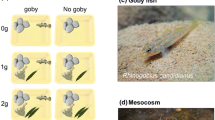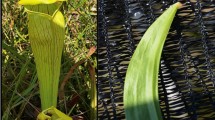Abstract
The effects of removal of live plants and litter (using herbicide, clipping, and raking) on seedling establishment were examined in Utricularia juncea (bladderwort), an annual carnivorous plant of low frequency in wet, nutrient-poor pine savannas of the southeastern United States. In addition, the spatial distribution of this species in relation to crayfish disturbances was determined. The creation of competition-free gaps in the groundcover canopy in May 1996 (using herbicide) promoted establishment of this species at two sites by September 1997. Standing dead and litter left in herbicide-treated plots inhibited establishment. Density was near zero in undisturbed plots. Natural occurrences of this species were associated with crayfish mounds, which bury plant litter as they erode and increase in area. These results suggest that Utricularia juncea is a fugitive species that depends on disturbances or litter-free microsites to become established in wet, nutrient-poor seepage savannas in southern Mississippi. It is hypothesized that the production of carnivorous traps combined with relatively high allocation to reproductive structures (>90%) and the production of a persistent seed bank make it well-adapted to nutrient-poor and disturbed habitats.
Similar content being viewed by others
References
Adams, R. M., II & Smith, G. W. 1977. An S.E.M. survey of the five carnivorous pitcher plant genera. Am. J. Bot. 64: 265-272.
Barker, N. G. & Williamson, G. B. 1988. Effects of a winter fire on Sarracenia alata and S. psittacina. Am. J. Bot. 75: 138-143.
Bergelson, J. 1990. Life after death: site pre-emption by the remains of Poa annua. Ecology 71: 2157-2165.
Brewer, J. S. 1998a. Effects of fire, competition, litter, and soil disturbances on regeneration of a carnivorous plant (Drosera capillaris). Am. Midland Nat. (in press).
Brewer, J. S. 1998b. Effects of competition and litter on a carnivorous plant, Drosera capillaris (Droseraceae). Am. J. Bot. (in press).
Brewer, J. S., Platt, W. J., Glitzenstein, J. S. & Streng, D. R. 1996. Effects of fire-generated gaps on growth and reproduction of golden aster (Pityopsis graminifolia). Bull. Torrey Bot. Club 123: 295-303.
Carson, W. P. & Peterson, C. L. 1990. The role of litter in an old-field community: impact of litter quantity in different seasons on plant species richness and abundance. Oecologia 85: 8-13.
Darwin, C. 1874. Insectivorous plants. Murray, London. 462 pp.
Day, R. T., Keddy, P. A., McNeill, J. & Carleton, T. 1988. Fertility and disturbance gradients: a summary model for riverine marsh vegetation. Ecology 69: 1044-1054.
Eleuterius L. N. 1968. Floristics and ecology of coastal bogs in Mississippi. M. S. Thesis, University of Southern Mississippi, Hattiesburg, MS.
Ellison, A. M. 1987. Effects of competition, disturbance, and herbivory on Salicornia europaea. Ecology 68: 576-586.
Facelli, J. M. 1994. Multiple indirect effects of plant litter affect the establishment of woody seedlings in old fields. Ecology 75: 1727-1735.
Folkerts, G. W. 1982. The Gulf Coast pitcher plant bogs. Am. Sci. 70: 260-267.
Foster, B. L., & Gross, K. L. 1997. Partitioning the effects of plant biomass and litter on Andropogon gerardi in old-field vegetation. Ecology 78: 2091-2104.
Gibson, T. C. 1983.Competition, disturbance, and the carnivorous plant community in the southeastern United States. Ph.D. Dissertation, University of Utah, Salt Lake City, UT.
Givnish, T. J. 1989. Ecology and evolution of carnivorous plants. Pp. 243-290. In: Abrahamson, W. G. (ed.), Plant-animal interactions. McGraw-Hill, New York.
Glitzenstein, J. S., Platt, W. J. & Streng, D. R. 1995. Effects of fire regime and habitat on tree dynamics in North Florida longleaf pine savannas. Ecol. Monog. 65: 441-476.
Goldberg, D. E. & Gross, K. L. 1988. Disturbance regimes of midsuccessional old fields. Ecology 69: 1677-1688.
Goldberg, D. E. & Werner, P. A. 1983. The effects of size of opening in vegetation and litter cover on seedling establishment of goldenrods (Solidago spp.). Oecologia 60: 149-155.
Grime, J. P. 1979. Plant strategies and vegetation processes. John Wiley and Sons, New York.
Harper, R. M. 1914. A superficial study of the pine-barren vegetation of Mississippi. Bull Torrey Bot. Club 41: 551-567.
Hilgard, E. W. 1860. A report on the geology and agriculture of the State of Mississippi. Mississippi State Geological Survey, Jackson, MS.
Hobbs, H. H., Jr. & Robison, H.W. 1989. On the crayfish genus Fallicambarus (Decapoda: Cambaridae) in Arkansas, with notes on the fodiens complex and descriptions of two new species. Proc. the Biol. Soc. Washington 102: 651-697.
Hobbs, R. J. & Mooney, H. A. 1991. Effects of rainfall variability and gopher disturbance on serpentine annual grassland dynamics. Ecology 72: 59-68.
Huston, M. A. 1994. Biological diversity: the coexistence of species on changing landscapes. Cambridge University Press, Cambridge, U.K.
Jefferies, R. L. 1988. Vegetational mosaics, plant-animal interactions and resources for plant growth. Pp. 341-369. In: Gottlieb, L. D. and Jain S. K. (eds), Plant Evolutionary Biology. Chapman and Hall, New York.
Johnston, C. E. & Figiel, C. 1997. Microhabitat parameters and lifehistory characteristics of Fallicambarus gordoni Fitzpatrick, a crayfish associated with pitcher-plant bogs in southern Mississippi. J. Crustacean Biol. 17: 687-691.
Juniper, B. E. & Buras, K. 1962. How pitcher plants trap insects. New Sci 13: 75-77.
Kaczor, S. A. & Hartnett, D. C. 1990. Gopher tortoise (Gopherus polyphemus) effects on soils and vegetation in a Florida sandhill community. Am. Midland Nat. 123: 100-111.
King, J. J. 1975. Inhibition of seed germination under leaf canopies in Arenaria serpyllifolia, Veronica arvensis and Cerastium holosteoides. New Phytol. 75: 87-90.
Kitajima, K. & Tilman, D. 1996. Seed banks and seedling establishment on an experimental productivity gradient. Oikos 76: 381-391.
Lloyd, F. E. 1942. The carnivorous plants. Chronica Botanica, Waltham, MA.
McDaniel, S. 1971. The genus Sarracenia (Sarraceniaceae). Bull. Tall Timbers Res. Station 9: 1-38.
Norquist, C. 1984. A comparative study of the soils and vegetation of savannas in Mississippi. M.S. Thesis. Mississippi State University, Mississippi State, MS.
Olson, M. S. & Platt, W. J. 1995. Effects of habitat and growing season fires on resprouting of shrubs in longleaf pine savannas. Vegetatio 119: 101-118.
Peet R. K. & Allard, D. J. 1993. Longleaf pine vegetation of the southern Atlantic and eastern Gulf Coast regions: a preliminary classification. Pp. 45-81. In Hermann, S. M. (eds), Proceedings of the Tall Timbers Fire Ecology Conference No. 18.
Platt, W. J. 1975. The colonization and formation of equilibrium plant species associations on badger disturbances in tallgrass prairie. Ecol. Monog. 45: 285-305.
Plummer, G. L. 1963. Soils of the pitcher plant habitats in the Georgia coastal plain. Ecology 44: 727-734.
Radford, A. E., Ahles, H. E. & Bell, C. R. 1968. Manual of the vascular flora of the Carolinas. The University of North Carolina Press, Chapel Hill, NC, USA.
Schnell, D. E. 1976. Carnivorous plants of the United States and Canada. John F. Blair, Winston-Salem, NC.
Streng, D. R. & Harcombe, P. A. 1982. Why don't east Texas savannas grow up to forest? Am. Midland Nat. 108: 278-294.
Sydes, C. & Grime, J. P. 1981. Effects of tree leaf litter on herbaceous vegetation in deciduous woodland. II. Experimental investigation. J. Ecol. 69: 249-262.
Tilman, D. 1988. Plant strategies and the dynamics and structure of plant communities. Princeton University Press, Princeton, NJ.
Walker, J. & Peet, R. K 1983. Composition and species diversity of pine-wiregrass savannas of the Green Swamp, North Carolina. Vegetatio 55: 163-179.
Weiss, T. E., Jr. 1980. The effects of fire and nutrient availability on the pitcher plant Sarracenia flava L. Ph.D. dissertation, University of Georgia, Athens, GA.
Wells, B. W. 1928. Plant communities of the coastal plain of North Carolina and their successional relations. Ecology 9: 230-242.
Wells, B. W. & Skunk, I. V. 1928. A Southern upland grass-sedge bog. North Carolina Agric. Exp. Station Techn. Bull. 32: 1075.
Werner, P. A. 1975. The effects of plant litter on germination in teasel, Dipsacus sylvestris Huds. Am. Midland Nat. 94: 470-476.
Wilson, S. D. 1985. The growth of Drosera intermedia in nutrientrich habitats: the role of insectivory and interspecific competition. Can. J. Bot. 63: 2468-2469.
Author information
Authors and Affiliations
Rights and permissions
About this article
Cite this article
Brewer, J.S. Effects of competition, litter, and disturbance on an annual carnivorous plant (Utricularia juncea). Plant Ecology 140, 159–165 (1999). https://doi.org/10.1023/A:1009796818877
Issue Date:
DOI: https://doi.org/10.1023/A:1009796818877




